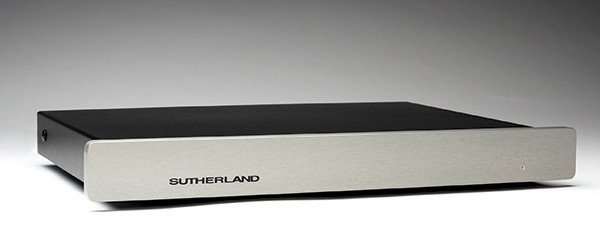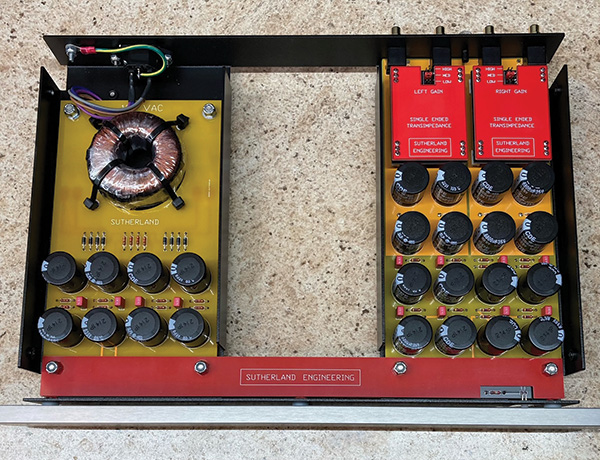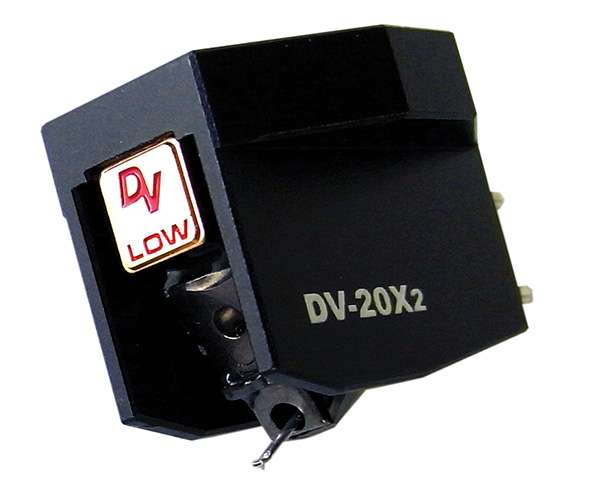| Columns Retired Columns & Blogs |
$3.8K for a hi-end phono stage, is a lot better than the stupefying price of $89K for the CH Precision P1 phono stage reviewed last week.
And this "could " even sound better at 24th of the price.
Cheers George

But when I write this monthly column, I find myself aiming for a different feel, more like driving cross-country in a '70s Ford station wagon, documenting motels and gas stations. A trip where it's fun to roll easy, take in the views, and stop at every car museum, snake farm, and stalactite cave.
This month, I'm going to put some miles on the Ford's odometer as I investigate the effects of Ron Sutherland's newest current-drive creation: a $3800 transimpedance moving coil headamp called the SUTZ. Along the way, I will also re-review Dynavector's $1250 DV-20X2 moving coil cartridge and examine what might be the sweetest spot in Dynavector's cartridge lineup: the $2150 XX-2 MKII.
Finally, I'll pull into a rest stop, get out of the car, and refamiliarize myself with Lounge Audio's $355 Copla headamp, a product I've used with enthusiasm since I reviewed it in February 2018 but have not written about since that first review.
Sutherland Engineering SUTZ
I've spent a lot of time trying to picture all the electromagnetic hoopla caused by wiggling a stick connected to some wire coils in a magnetic field. I've pictured the bumpy record grooves shaking a tiny stylus/cantilever/coil assembly, stretching its tensioning wire while swinging its coils through the fixed lines of magnetic flux created by a very small equivalent of a horseshoe magnet. As the coils move through the magnet's flux, an electric current is induced along their length.
I learned to picture this Faraday's law part in grade school. In high school, a teacher explained Lenz's law, and that was trickier to comprehend: "The polarity of the voltage generated by changes in magnetic flux produces a current whose magnetic field opposes the change which produced it."
Surprisingly, as I worked to imagine how current-drive audio stages work and why they affect the sound of cartridges the way they do, I remembered Lenz's law and its magnetic pushback. That memory caused me to speculate that loading a moving coil cartridge with a virtual short (no voltage at the input) would maximize current flow through the cartridge coils, which in turn would max out the force of the Lenz's law pushback, instituting the greatest possible damping on cantilever-coil motions (footnote 1).
Next, I tried to imagine how this current-induced damping might compare to the damping instituted by a traditional shunt resistor preceding an active stage. I've always presumed that all differences in loading/damping affect how reliably the stylus traces the record's grooves, and I had already concluded that differences in damping (however they arise) are responsible for differences in tracking, groove noise, the sense of inner detail, and intermodulation distortion.
And then my Herb-brain wondered: what about step-up transformers?
To date, I've reviewed a bushel of shunt-load phono stages, a variety of step-up transformers, and three "transimpedance" phono stages: Lounge Audio's $355 Copla, Dynavector's $895 P75 MK3 phono preamplifier, and Sutherland Engineering's $3800 Little Loco.
Historically, my taste in phonographic reproduction has favored high-nickel step-up transformers attempting to disappear in front of the atmospherics and incandescence of tubed RIAA equalizers. Lately, though, I've been bathing in the high densities of low-signal information being recovered by Sutherland Engineering's Little Loco current-drive phono preamplifier, which I've been using with the My Sonic Lab low-output (0.3mV), low-impedance (0.6 ohm) Ultra Eminent EX moving coil cartridge. The Little Loco seems to magnify every little thing this cartridge gives it. Compared to how the Eminent EX sounds into Parasound's Halo JC 3+ phono stage, the My Sonic–Loco combo played bigger (image and soundspace-wise) and more elegantly (texture and proportion-wise)—with an abyss-deep silence sitting behind the notes.
So suddenly I have this dilemma: How do I get all that short-circuit silence and grainless microdata and not be forced to give up the CinemaScope and Technicolor of tubed RIAA stages?
I explained this dilemma to my "turntable-whisperer" friend Chad Stelly, and he explained it to our mutual friend Ron Sutherland of Sutherland Engineering (footnote 2); Ron responded immediately: "I've already solved that!" A week later, I'm connecting Ron's newest invention, the "SUTZ" transimpedance headamplifier, to the 47k ohm moving magnet input of my all-tube Tavish Design Adagio phono stage.

Sutherland Engineering's SUTZ headamp arrived in the same 17" × 2" × 13" chassis as the Little Loco preamp I described in the January 2022 Stereophile. In fact, the SUTZ looks exactly the same, inside and out, as the Little Loco. Inside, it sports the same three jumper-activated Gain settings as the Little Loco. When I asked how much gain the SUTZ makes, Ron told me in an email that all future SUTZ will have five gain settings; but only after scolding me, explaining that "transimpedance amps do not have 'gain' because the units in (amperes) are different than the units out (volts)." (footnote 3)
Before I begin my listening stories, I should mention that the component grouping I used was what I call my all-tube "real-fi" system: cartridge and step-up transformer du jour, attached to a 10.5" Thomas Schick tonearm attached to Dr. Feickert's Blackbird record spinner, feeding Tavish Design's Adagio phono stage or SunValley's SV EQ1616D phono equalizer, feeding Lab 12's Pre 1 line-level preamplifier, into Elekit's TU-8600S SE amplifier (with Western Electric 300B tubes) powering Falcon Gold Badge speakers. During these auditions, I was constantly reminded how much I enjoy this system and how it plays recordings with greater verity of tone and lifelikeness than any system I've assembled since I started writing for Stereophile.

Dynavector DV-20X2
Since I reviewed it in Gramophone Dreams #10, no cartridge has played more discs in my room than Dynavector's $1250 DV-20X2 moving coil. I've put hundreds of hours on it, playing it through at least a dozen phono stages. It plays the way I like phono cartridges to play: clear, fast, and insightfully. It's got enough mojo-vivo to make high-energy recordings with sword-sharp transients sound gunshot explosive and utterly relaxed at the same time. Few cartridges at this price level can do both. Many can't do either.
Even with all those hours on it, the 20X2 had no difficulty doing this explosive-but-relaxed thing while cleanly reproducing one of field-recordist David Lewiston's finest and most popular recordings: "Ketjak: the Ramayana Monkey Chant" from the Nonesuch Explorer Series LP Golden Rain (Nonesuch Explorer LP H72028). The powerful percussive transients generated by 200 monks chanting in unison came through as startling, even when I knew their shouted "tjak" outbursts were coming. The concentric arrangement of the monks in the courtyard was easily discernable. During quiet passages, my mind's eye enjoyed pinpointing the location of individual monks chanting at the far sides of these circles. When the monks paused their shouting, the ambient sounds of the courtyard allowed me to see and feel their presence. Cartridges with this degree of insightfulness are rare at this price level.

Every time I played "Monkey Chant" with the Dynavector's 20X2 MC into the Sutherland SUTZ and the all-tube SunValley SV EQ1616D phono equalizer, I was awed and dizzified by the raw clarity, breakneck speed, and free-swinging dynamics of the presentation; those "tjak" transients came through sharply and powerfully with noticeable spaces between chanters' voices. For me, this was a new type of Wow! moment: current-drive information aesthetically enhanced by the SunValley's tubes.

Dynavector XX-2 MKII
Chad Stelly raved to me in texts about the "incredible synergy" of Dynavector's XX-2 MKII moving coil with the Sutherland SUTZ, so I contacted Mike Pranka at Toffco, Dynavector's US distributor (footnote 4), and he corroborated Chad's observation: At $2150, the XX-2 MKII is probably the "sweet spot" in Dynavector's cartridge lineup. It's the point where the biggest portion of Dynavector excitement kicks in.
My ongoing attraction to Dynavector cartridges is fueled by their claims that they focus their engineering programs at the heart of the matter: magnetic circuit design. Their website explains, "By our calculation and experiments, it was proved that even a very small deviation of flux makes a change of magnetic force in the air gap, which affects intermodulated distortion in the output signal." That is why Dynavector favors Alnico 5 magnets over samarium cobalt or neodymium boron. The stated purpose of Dynavector's patented "flux damping" and "softened magnetism" is to minimize "unfavored magnetic fluctuation."
The XX-2 MKII uses Alnico 5 magnets (footnote 5) because they exhibit high magnetic flux density, which "generates a more stable flux-field which maintains a more stable output voltage" than other magnet types, according to the Dynavector website.
The XX-2 MKII sports a low (6 ohm) internal resistance and a low, 0.28mV output voltage. Its motor is housed in a rigid 7075 aluminum body, and the cartridge weighs 9.2gm. Compliance is specified at 10µm/mN, and Dynavector recommends a low (30 ohm) load.
The 20X2 uses a nude MicroRidge stylus on a hard aluminum-pipe cantilever, whereas the XX-2 is the lowest-priced cartridge in the Dynavector lineup that uses a solid boron cantilever, tipped with a 7 × 30µm Pathfinder line-contact stylus—which, if I remember correctly, is the same Ogura diamond used by Lyra and Koetsu.
Footnote 2: Sutherland Engineering. Tel: (816) 718-7898. Web: sutherlandengineering.com
Footnote 3: Technically, there's no difficulty defining gain for a transimpedance phono preamp: It's the same as always, the ratio of voltage out to voltage in or current out to current in—pick one. But that is not the quantity of interest for a current-input phono stage, the job of which is to transform current into voltage. For such a device, the analogy to a step-up transformer is irresistible; that's probably responsible for Ron Sutherland's decision to call this product the SUTZ: You can think of it as a new kind of step-up transformer even if it's not a transformer in the usual sense. Why the Z on the end? Probably because the natural way to characterize a transimpedance device is via the ratio of the output voltage to the input current, which has units of impedance, and impedance is commonly indicated by the letter Z.—Jim Austin
Footnote 4: Dynavector Systems Ltd., 3-2-7 Higashi-Kanda Chiyoda-ku Tokyo 101-0031 Japan. Tel: +81 (0) 3-3861-4341. Web: dynavector.com. US distributor: Toffco, 2020 Washington Ave., Unit 314, St. Louis, MO 63103. Tel: (314) 454-9966. Web: dynavector-usa.com
Footnote 5: The number after "Alnico" indicates the particular alloy of aluminum, nickel, cobalt, copper, and iron. Alnico 5 is especially rich in cobalt and slightly more magnetic than other Alnico alloys. For what it's worth, electric guitars with pickups based on Alnico 5 are said to have sharper transients and brighter tone.—Jim Austin

$3.8K for a hi-end phono stage, is a lot better than the stupefying price of $89K for the CH Precision P1 phono stage reviewed last week.
And this "could " even sound better at 24th of the price.
Cheers George

I would like to understand how the transimpedance phono stage can sound open and airy while loading the cartridge into such a low impedance.
Many years of experience with traditional phono stages has shown me that an incorrect too low load will dull the sound of a cartridge.
Why doesn’t this occur with the transimpedance type phono stage?

"how the transimpedance phono stage can sound open and airy"
Think it works a bit like very low impedance speakers, they need/suck more current from the amp, And let face it, the easy to drive speakers are usually more coloured than the low impedance less coloured ones.
We loaded a Supex SD900 with 1000ohm, 500ohm, 100ohm, 50ohm, and 10ohm the cleanest best damped sound came from the 10ohm loading, but you need higher gain for it, which "can" run into more noise if things aren't designed right.
Cheers George

After reading this I ordered a SunValley EQ1616D kit and a Lounge Audio Coppola with silver wiring and a switch.
I got the SunValley kit in 3 days.
From the Lounge Audio people I got an email saying they'd let me know when they shipped it.
That was 2 weeks ago and I haven't heard from them. They have not answered the 3 emails I sent them.
If for whatever reason it takes awhile to get one that's OK but 1) no response is not when they were happy enough to take and hold my $550, and 2) it should say prominently somewhere on their website that I will be waiting awhile.

Quote from Lounge Audio's site on shipping
"SHIPPING
We ship via USPS Priority Mail 1-3 days with signature confirmation in a large flat rate box (12x12x6) anywhere in the US.
We ship to any APO/FPO or DPO. We do not ship to proxy logistics companies.
We handcraft the unit at our location and it takes us one to two days to ship the preamp from the moment you place the order."
I direct your attention to
"...it takes us one to two days to ship the preamp from the moment you place the order."